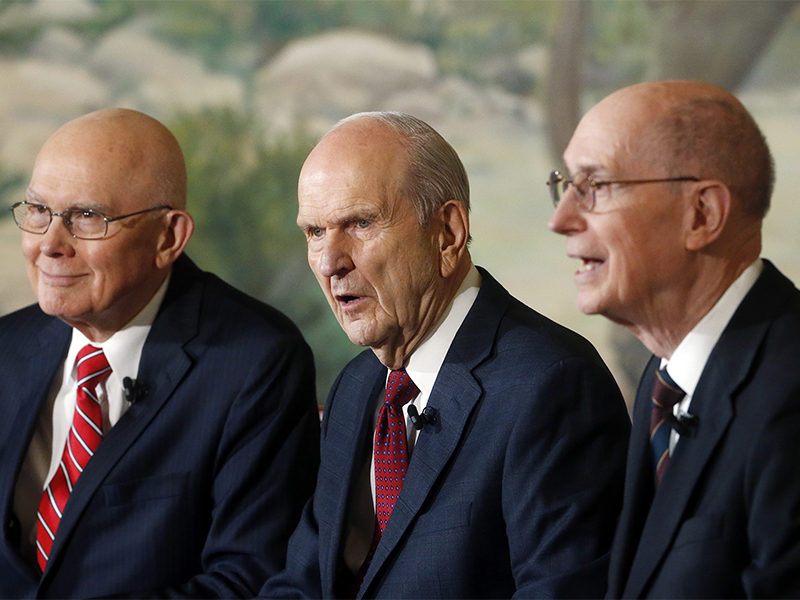

President Russell M. Nelson, center, speaks as his counselors Dallin H. Oaks, left, and Henry B. Eyring, right, look on during a news conference announcing his new leadership in the wake of the death of President Thomas S. Monson on Jan. 16, 2018, in Salt Lake City. (AP Photo/Rick Bowmer)
January 17, 2018



![]()
(RNS) — The Church of Jesus Christ of Latter-day Saints rolled out its new president, prophet and revelator on Tuesday (Jan 16), and I’m happy to report that Russell M. Nelson seems about as compos mentis as any 93-year-old I’ve run into.
On the other hand, he and the dozen Apostles, including his counselors Dallin H. Oaks, 85, and Henry B. Eyring, 84, conveyed the image of their increasingly diverse and far-flung communion about as well as a convention of retired Midwestern pharmacists, c. 1955.
The revelation for me occurred during the livestreamed news conference, when Nelson called on Peggy Fletcher Stack, the Salt Lake Tribune’s award-winning religion reporter, who has been covering the LDS Church since 1991.
Stack: “So under President Monson we saw some real advances towards gender equity — the lowering of the missionary age, especially for sisters, and also adding women to some of the executive committees, but the Church leadership is still white, male, American. What will you do in your presidency to bring women, people of color, and international members into decision-making for the Church?”

Nelson: “That’s a good question, Peggy. I hope I can be forgiven if I say I have a special place in my heart for you. I know your mother. I know your father. I know all four of your grandparents. And I know your family — your missionary children who’ve distinguished themselves with wonderful service — so Peggy is special to me. Um, now what was your question?”
Question for the class: Nelson’s response was (a) unprofessional; (b) patronizing; (c) sexist; (d) creepy; (e) all of the above.
Whatever. He then proceeded to point out that while the Church’s top leadership is white and American, “wherever we go, the leadership of the Church is from the local communities” even if the apex of the hierarchy is unrepresentative. “How,” he asked, “would you govern a Church with representatives from all of the 188 countries?”
That the Roman Catholic Church has done a reasonably good job of answering that one seems not to have occurred to him.
Oaks then offered a little lecture about how he tells youth that “it’s dangerous to label themselves as of a particular nationality, geographic origin, ethnic circumstance or whatever it may be, because the most important thing about us is that we are all children of God. If we keep that in mind, we’re better suited to relate to one another and to avoid a kind of quota system, as if God applied His blessings and extended His goodness and His love on the basis of quotas that I think He does not recognize. So we shouldn’t.”
Whereupon Stack asked, “What about women?”
Nelson: “I love ’em. I have a special place in my heart about the women.”
“We need their influence,” chimed in Eyring.
American religious historians contend that 19th-century Mormonism succeeded precisely because of its emphasis on patriarchy, which appealed to people put off by the growing feminization of American Protestantism. If that’s the road to success the new LDS leadership team is banking on, it’s off to a good start.